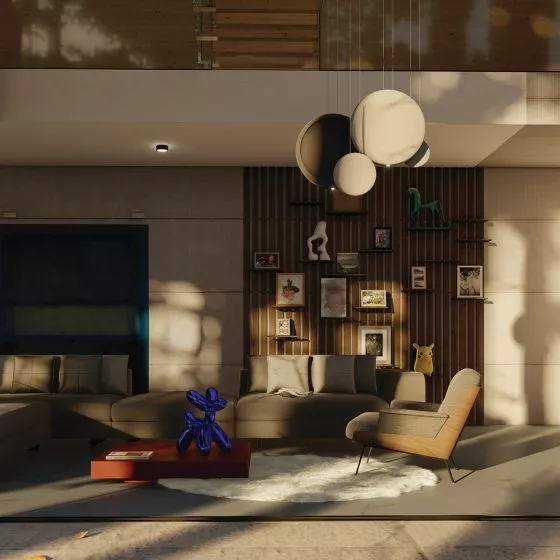{Student}, a graduate of the Silesian University of Technology, chose the picturesque Zielonki area near Krakow for the design of the Agricultural Science Research Center. His proposed buildings are an example of interface architecture, a place where the boundaries of the city and nature meet.
The premise of Kamil Kajdas' project is to create a Research Center for Agricultural Sciences in Zielonki near Krakow, which is both a border and a link with the city. As the author believes, the Zielonki area is a good example of the border between the city and nature. The area is marked by the line of the Landscape Park and the 3rd defensive line of the Krakow Fortress running through it. The Research Center's task is to control the changes taking place in agriculture and the impact of these activities on the landscape.
The Research Center is a border and a link to the city
© Kamil Kajdas
architecture of the interface
In these days of progressive social development and the widespread phenomenon of urban sprawl, the concept of a city bound ary in functional and visual terms is very difficult to define. Historically, the area of the city boundary was defined by a wall [...]. With the advent of urban development changes, the concept of boundaries began to blur, as a result of which they are hard to define. The nature of the architecture presenting the city's contact should express visually and emotionally its borders. In defining the area of contact, the meaning of the city's boundary should be redefined. It should not be a barrier, but become a connector [...]. Architecture should pose a pretext for reflection on both border areas. The meaning of the interface should be read as a whole, but also present a collection of recorded histories at its individual points. This procedure was implemented in my project by creating a typology of contemporary city walls," explains Kamil Kajdas.
The Agricultural Research Center consists of five buildings spread out over the site
© Kamil Kajdas
new life of forts
The goal of Kamil Kardas' master's thesis, done under the supervision of Dr. Jan Kubec at the Silesian University of Technology, was to create a spatial framework that testifies to the boundary between the urban area and nature. Historical references are based on the typology of buildings (there are former military forts in the area), which forms the complex of the Agricultural Research Center. Landscape conditions influenced the urban layout of the five buildings, and the composition was inscribed in the structure of the existing forts.
The research center is divided into three parts
© Kamil Kajdas
The Research Center building is founded on monolithic reinforced concrete walls driven into the undulating terrain. Growing out of the ground, the building has gaps in the walls where the author placed the three functions of the foundation. Between the science building and the fort the Nature Bank was designed, the entrance of which also leads to the warehouses. The body of this building also took a simple, monolithic form.
The site also includes a meteorological tower and Fort 45 Marszowiec adapted into a tourist center and hotel
© Kamil Kajdas
The adapted forts, overgrown with greenery, form a dominant landscape feature. Fort 45 Mar szowiec has been converted into a tourist center with a hotel. In Auxiliary Fort 45a Bibice, the architect proposed a tourist pavilion. Another compositional accent is a tower used for research and meteorological observations creating a strong accent in the space. Thanks to balanced proportions, the tower does not dominate against the background of the whole establishment, and its scale has been adjusted to the undulating terrain.
The center's building is formed by reinforced concrete walls
© Kamil Kajdas
reinforced concrete monoliths
The entire premise was designed in a wall and frame structural system for the underground parking lots, and storage areas. The building consists of reinforced concrete monolithic walls, driven into the ground. In addition to their structural function for the floors, the walls are retaining walls. They were designed as massive semi-prefabricated reinforced concrete with a height of three stories. Ceilings and roofs are made of prefabricated slabs supported on reinforced concrete beams with a maximum span of eight meters.
The Agricultural Science Research Center is also open to visitors
© Kamil Kajdas
Creating the architecture of the interface should focus on the individual character of the place - the social structure, culture, history and spatial conditions in which it is located. In setting spatial directions, I referred in my work to the historical boundaries of the city - the city walls. The changing landscape structure and its degradation created the field for the formation of the Research Center for Agricultural Sciences - a research unit dealing with the field that has the greatest impact on the protected landscape," the author concludes.
Kamil Kajdas' project received an honorable mention in the master's thesis category in a competition organized by the Polish "Green Roofs" Association, whose goals, were to select the best theses in the field of green roofs and living walls.
In the same competition, Dobrochna Lata also received an honorable mention for her design of the Museum of Unnatural History, and the first prize in the engineering thesis category, went to Lukasz Modrzejewski for his design of a hostel for cyclists.






















































